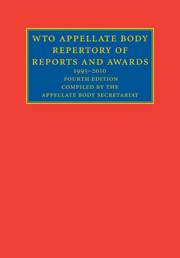Book contents
- Frontmatter
- Contents (outline)
- Contents (detail)
- Foreword to the 1995–2010 edition
- Part I Appellate Body Reports
- A
- B
- C
- D
- E
- F
- G
- H
- I
- J
- L
- M
- N
- O
- P
- R
- S
- T
- V
- W
- Part II Arbitration Awards under Article 21.3(c) of the DSU
- Annex A Terms of Office of Current and Former Appellate Body Members and Chairpersons – 31 December 2009
- Annex B Biographies of Current and Former Appellate Body Members
- Annex C Information on Appellate Body Reports – 1996 to January 2010
- Annex D Arbitration Awards under Article 21.3(c) of the DSU – 1996 to 2009
- Annex E Articles of Covered Agreements Addressed in Appellate Body Reports
- Annex F Working Procedures for Appellate Review WT/AB/WP/61
- Abbreviations used in the Table of References to the Covered Agreements and other Instruments and in the Indexes
- Table of References to the Covered Agreements and other Instruments by Article
- Index
- Subject Index by Case (Appellate Body reports)
- Subject Index by Case (Arbitration Awards under Article 21.3(c) of the DSU)
H
from Part I - Appellate Body Reports
Published online by Cambridge University Press: 05 June 2012
- Frontmatter
- Contents (outline)
- Contents (detail)
- Foreword to the 1995–2010 edition
- Part I Appellate Body Reports
- A
- B
- C
- D
- E
- F
- G
- H
- I
- J
- L
- M
- N
- O
- P
- R
- S
- T
- V
- W
- Part II Arbitration Awards under Article 21.3(c) of the DSU
- Annex A Terms of Office of Current and Former Appellate Body Members and Chairpersons – 31 December 2009
- Annex B Biographies of Current and Former Appellate Body Members
- Annex C Information on Appellate Body Reports – 1996 to January 2010
- Annex D Arbitration Awards under Article 21.3(c) of the DSU – 1996 to 2009
- Annex E Articles of Covered Agreements Addressed in Appellate Body Reports
- Annex F Working Procedures for Appellate Review WT/AB/WP/61
- Abbreviations used in the Table of References to the Covered Agreements and other Instruments and in the Indexes
- Table of References to the Covered Agreements and other Instruments by Article
- Index
- Subject Index by Case (Appellate Body reports)
- Subject Index by Case (Arbitration Awards under Article 21.3(c) of the DSU)
Summary
(WT/DS8/AB/R, WT/DS10/AB/R, WT/DS11/AB/R)
Uniform classification in tariff nomenclatures based on the Harmonized System (the “HS”) was recognized in GATT 1947 practice as providing a useful basis for confirming “likeness” in products. However, there is a major difference between tariff classification nomenclature and tariff bindings or concessions made by Members of the WTO under Article of the GATT 1994.…
…tariff bindings that include a wide range of products are not a reliable criterion for determining or confirming product “likeness” under Article III:2.
EC – Computer Equipment, paras. 89–90
(WT/DS62/AB/R, WT/DS67/AB/R, WT/DS68/AB/R)
…We believe, however, that a proper interpretation of Schedule LXXXshould have included an examination of the Harmonized System and its Explanatory Notes.
…we consider that in interpreting the tariff concessions in Schedule LXXX, decisions of the WCO may be relevant …
EC – Chicken Cuts, para. 195
(WT/DS269/AB/R, WT/DS286/AB/R, WT/DS269/AB/R/Corr.1, WT/DS286/AB/R/Corr.1)
The Harmonized System is not, formally, part of the WTO Agreement, as it has not been incorporated, in whole or in part, into that Agreement. Nevertheless, the concept of “context”, under Article 31, is not limited to the treaty text – namely, the WTO Agreement – but may also extend to “any agreement relating to the treaty which was made between all the parties in connection with the conclusion of the treaty”, within the meaning of Article 31(2)(a) of the Vienna Convention, and to “any instrument which was made by one or more parties in connection with the conclusion of the treaty and accepted by the other parties as an instrument related to the treaty” within the meaning of Article 31(2)(b) of the Vienna Convention.…
- Type
- Chapter
- Information
- WTO Appellate Body Repertory of Reports and Awards1995–2010, pp. 423 - 427Publisher: Cambridge University PressPrint publication year: 2011



